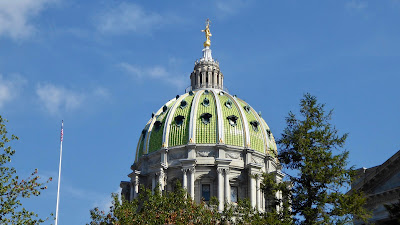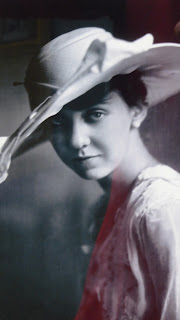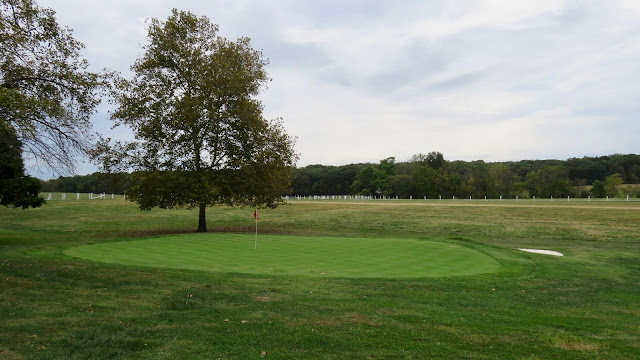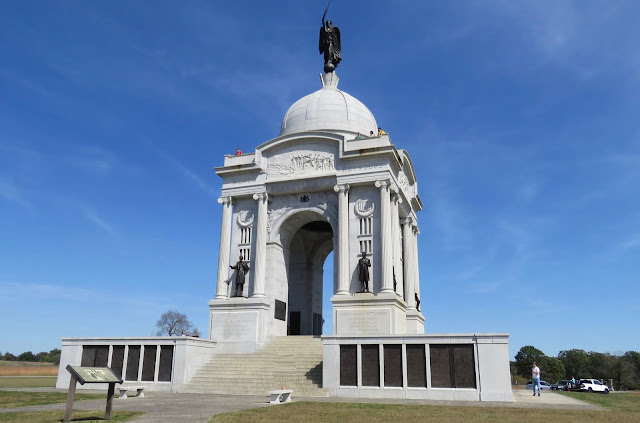Carol writes: From upstate New York, our motorhome route dipped back down into central Pennsylvania, where we had some very memorable excursions through the pages of American history. First, though, we sampled a little collegiate history at our first campground in Woodland, Pennsylvania, where we took a day-trip to the campus of one of our country’s finest universities—Penn State. Iconic scenes of Penn State campus life included:
sentimental Old Main;
the football stadium, scene of many legendary Penn State victories;
and the beloved statue of Penn State’s mascot, the Nittany lion.
What impressed us most about Penn State was the vast number of students we saw seriously immersed in their studies on this beautiful, warm and sunny Sunday afternoon.
At our next campground in Elizabethtown, Pennsylvania, we found ourselves in the shadow of the nuclear stacks of the infamous Three Mile Island Nuclear Generating Station, which suffered a partial meltdown in 1979.
As it turned out, Three Mile Island ceased operations a few days after we arrived as the steam exhaust from the nuclear towers slowly dwindled and vanished with a whisper.
Any campground within driving distance of a state capital offers the bonus of a visit. And so it was at Elizabethtown, 20 miles from the capital city of the Keystone state at Harrisburg. Certainly, this Capitol complex was a close rival to the one we had recently visited in Albany. The Capitol Building was breathtakingly beautiful.
The exterior of the dome was covered in green-glazed terra cotta tile, thus creating a most unique look for a capitol dome. Inside, the building was a grand combination of classical styles—Italian Renaissance along with Greek, Roman, and Victorian influences.
We observed gold gilded surfaces galore!
The legislative chambers resembled palaces we had visited in Europe.
Not surprisingly, when the Capitol building officially opened in 1906, keynote speaker President Theodore Roosevelt declared it was “the handsomest capitol I ever saw.”
A day-trip to nearby Lancaster, Pennsylvania, provided a good peek at Pennsylvania Amish Country. The star of downtown Lancaster was the Lancaster Central Market.
This market was established in 1730, making it the oldest continually operating farmers’ market in the United States. Some of the stands at this market have been operated by the same families for several generations. We found a yummy variety of bread and cheese for our motorhome pantry.
Lancaster was also home to James Buchanan, our nation’s 15th president. Buchanan’s term in office (1856-1860) directly preceded that of Abraham Lincoln. Voters hoped that James Buchanan’s vast expertise as a politician and diplomat would temper the bitter slavery arguments of the day that had been fomenting between the North and the South.
Although Buchanan thought secession was unconstitutional, he believed the federal government had no power to stop it, and so he dithered on the sidelines for all four years of his presidential term while his country crumbled all around him. Ultimately, the first southern states seceded from the Union in the opening year of Lincoln’s presidency. Buchanan stubbornly insisted that although slavery might be morally wrong, the federal government had no power to supersede States’ rights. Buchanan’s avowed strict constructionist view of the Constitution ultimately resulted in a cavalcade of events that resulted in the Civil War. Rightfully, history has not dealt kindly with the Buchanan presidency, and none of this was glossed over at the presidential site…
James Buchanan was our only president who never married. His niece, Harriet Lane Johnston, acted as First Lady during his presidency. By all accounts, Harriet was a very popular Washington hostess. Her fashion style was copied widely, especially after she showed up at diplomatic functions in dresses with necklines that were significantly lower than the gowns of the time. I found it fascinating that she remained a close friend to Queen Victoria and Prince Albert until the end of Victoria’s life in 1901.
Known as Wheatland, the Buchanan home was a large brick Federal-style house located in a residential area of Lancaster.
Many pieces in the home belonged to the Buchanan family, especially those in the library.
Eight years after retiring from Washington, President Buchanan died in his own bed at his beloved Wheatland home.
Other historically interesting details on the house tour were:
Harriet Lane Johnston’s bedroom…
the President’s indoor bathroom, complete with large metal bathtub and lovely washstand…
and this Madeira red dated 1827, the only remaining unopened bottle of wine from the Buchanan wine cellar.
Prior to our October Annapolis reunion festivities, our last campground in south central Pennsylvania, was in historic Gettysburg.
Dwight David Eisenhower, our 34th President, was born in Texas, grew up in Kansas, and retired to his beloved farm just outside of Gettysburg, Pennsylvania, after serving 8 years in the presidency. Always the soldier, Eisenhower had a fascination with the Battle of Gettysburg, the turning point in the Civil War, and so it wasn’t surprising that Gettysburg was selected as the location of Ike and Mamie’s retirement dream home, the only home they would ever own together.
For a former president who was one of the world’s great soldiers and statesmen, the so-called Georgian-style Eisenhower farmhouse was modest in the extreme; nevertheless, this little piece of paradise in the rolling Pennsylvania hills was much loved by Ike and Mamie. The furnishings of the home were much as the Eisenhowers left it.
The “stuffy” (Ike’s words, not mine) formal living room was a reflection of the public life of the Eisenhowers.
A modest screened-in porch area was the heartbeat of the home. This was the place where the Eisenhowers enjoyed their happiest social activities. This very back porch was where Nikita Khrushchev, among other world leaders, had intimate conversations with President Eisenhower.
It almost seemed intrusive to be allowed a glimpse into the Eisenhower bedroom…
In this cozy den, it was easy to imagine the former president relaxing and composing his memoirs about such a remarkable and admirable life.
Eisenhower oil paintings decorated the walls of the home throughout.
The self-guided farm part of the tour consisted of a variety of barns and sheds, with plenty of signage about Ike’s award-winning Black Angus cattle enterprise,
Of course, there was also a putting green.
The Battle of Gettysburg has been so meticulously documented that we felt the story of this pivotal Civil War battle was deserving of a couple of days of full immersion.
I was fascinated by the details of some of the lesser known stories associated with the Battle of Gettysburg, like the one about 20-year-old Jennie Wade, the only direct civilian casualty of the battle. While kneading dough in her kitchen, Jennie died instantly after being shot in the back by a stray bullet.
Normally, I’m not terribly interested in battle tactics, but at Gettysburg I was won over. As a lover and reader of history, Al already knew many of the details of the battlefield maneuvers that we were to study together over the next two days.
At the run-up to the Battle of Gettysburg, Confederate troops were nearby to the north, east and west of the town of Gettysburg. Union troops were to the south and southeast. Ten roads converged on Gettysburg like the spokes of a wheel, thus providing both armies easy transport in.
We drove through the battlefield on an excellent 24-mile autoroute that explained all three days of the hellish battle that was waged around the tiny village of Gettysburg during the first three days of July in 1863. The fact that the autoroute was chronological made battle tactics very understandable. For true understanding, there was nothing that compared to standing in the actual geographic setting and surveying the surrounding landscape where pivotal events of the battle played out.
From small to gigantic, over a thousand monuments dotted the Gettysburg Battlefield. The Pennsylvania Monument was the largest, commemorating over 34,000 soldiers from Pennsylvania who fought at Gettysburg.
The Virginia Memorial monument with Robert E. Lee mounted atop his horse Traveller was one of the most impressive.
Poignantly, this monument looked out across the large grassy field where the deciding moment of the battle took place. The last Confederate assault, otherwise known as Pickett’s Charge, took place here against Union troops led by General George Meade.
Other equally moving venues of incredible losses at Gettysburg included:
the Devil’s Den,
the Peach Orchard,
and the high ground where General Gouverneur Warren played a key part in the Union’s successful defense of Little Round Top.
The Battle of Gettysburg was the bloodiest battle of the Civil War, with over 51,000 soldiers dead, wounded, or missing. Robert E. Lee’s defeat at Gettysburg marked a significant turning point of the war in favor of the Union.
Four months after the Battle of Gettysburg, Abraham Lincoln was invited to come to Gettysburg to “make a few appropriate remarks” at the dedication of the Soldiers’ National Cemetery. Lincoln arrived by train at the Gettysburg train station.
Lincoln’s 272-word Gettysburg Address took only two minutes to deliver, yet it has been called a masterpiece of the English language.
The precise spot where Lincoln stood to deliver his address on November 19, 1863, is not known for certain, but the words he spoke will never be forgotten, despite Lincoln’s ironic assertion that “the world will little note nor long remember what we say here…”
Our visit to the Battle of Gettysburg was a moving one. We were once again saddened and moved at the tragedy of a nation pitting one citizen against another. As we were leaving the cemetery, we spotted a plaque that summed up our emotions of the week quite eloquently…
On fame’s eternal camping-ground
Their silent tents are spread,
And glory guards with solemn round
The bivouac of the dead.
Carol Galus
Photo-Blogger















































No comments:
Post a Comment